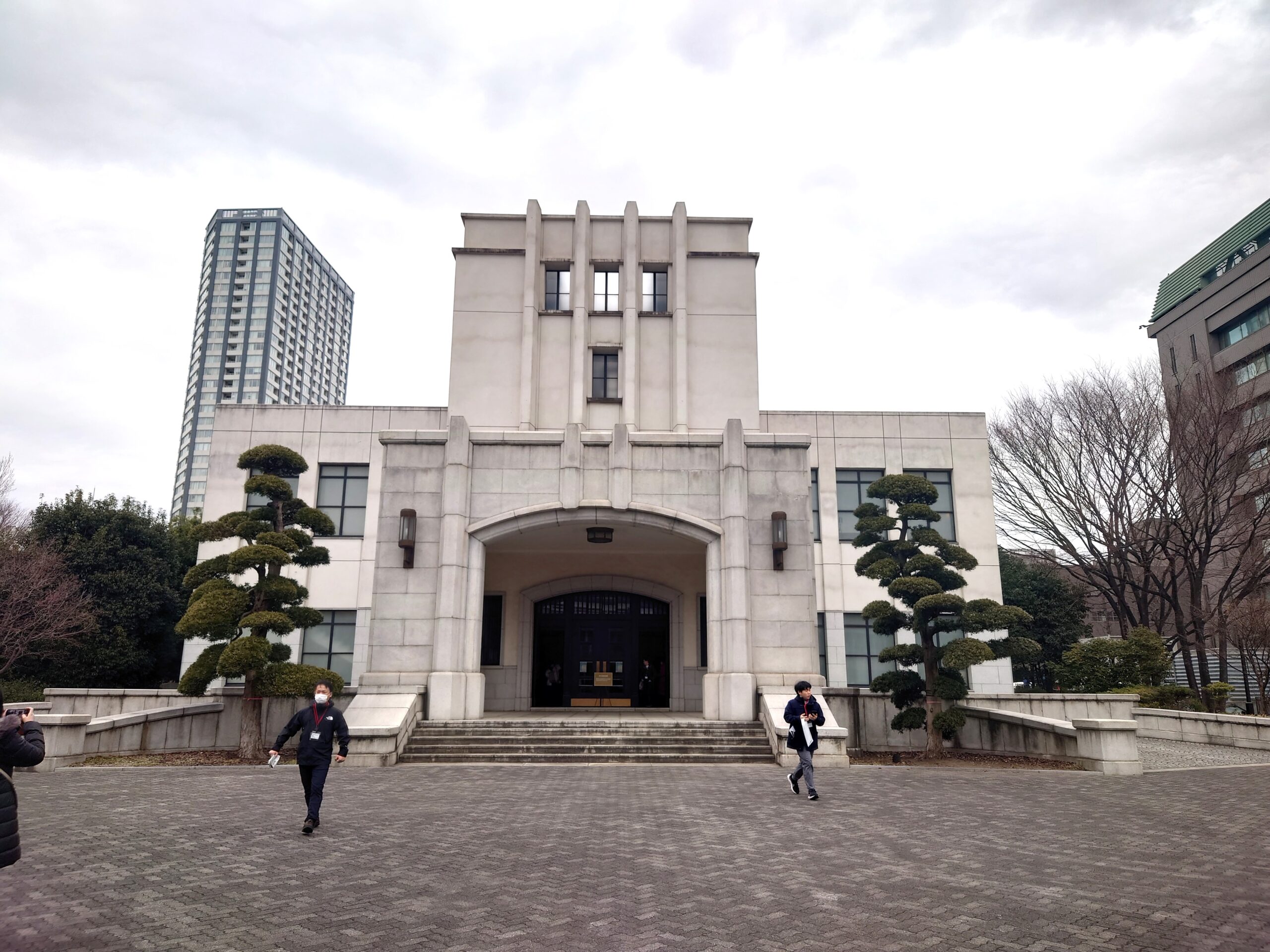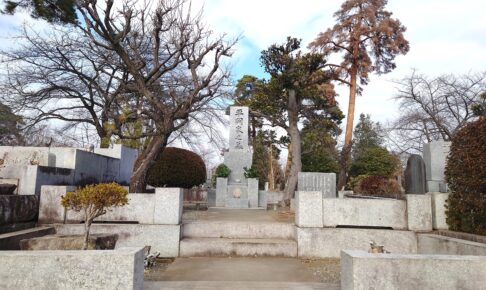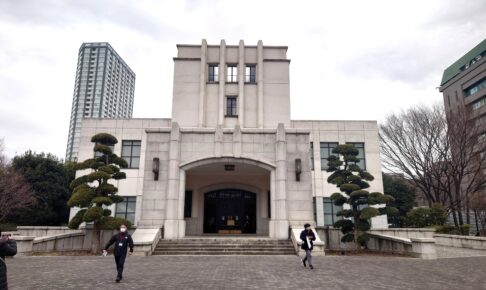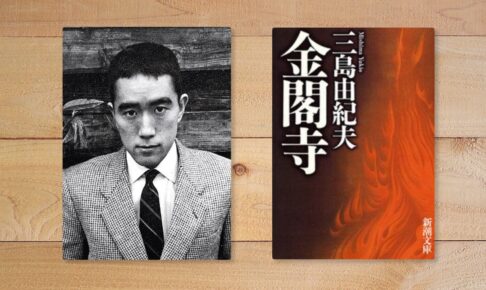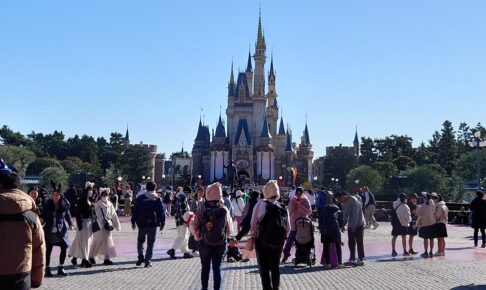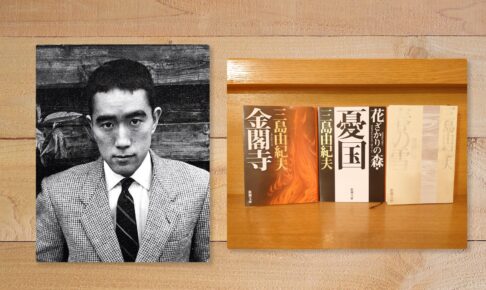Table of Contents
Travels to Buddhist sites in India and Sri Lanka (61)
The Fierce Last Days of Yukio Mishima! What was happening at the site of his suicide that day?
Introduction.
A week before the departure of the third expedition to India, I was in Tokyo.
After returning from Sri Lanka, I had been furiously learning about Yukio Mishima, but there was one place I really wanted to visit before leaving for India. I wanted to visit the Self-Defense Forces Ichigaya Camp, the site of Yukio Mishima's suicide.
I found out that the site is now being used as the Ministry of Defense, and to my surprise, the site where Yukio Mishima committed suicide is included in the tour of the Ministry of Defense! I had to go. I hurriedly applied for the tour and came to Tokyo.
Self-Defense Forces Garrison Ichigaya (to present Ministry of Defense)
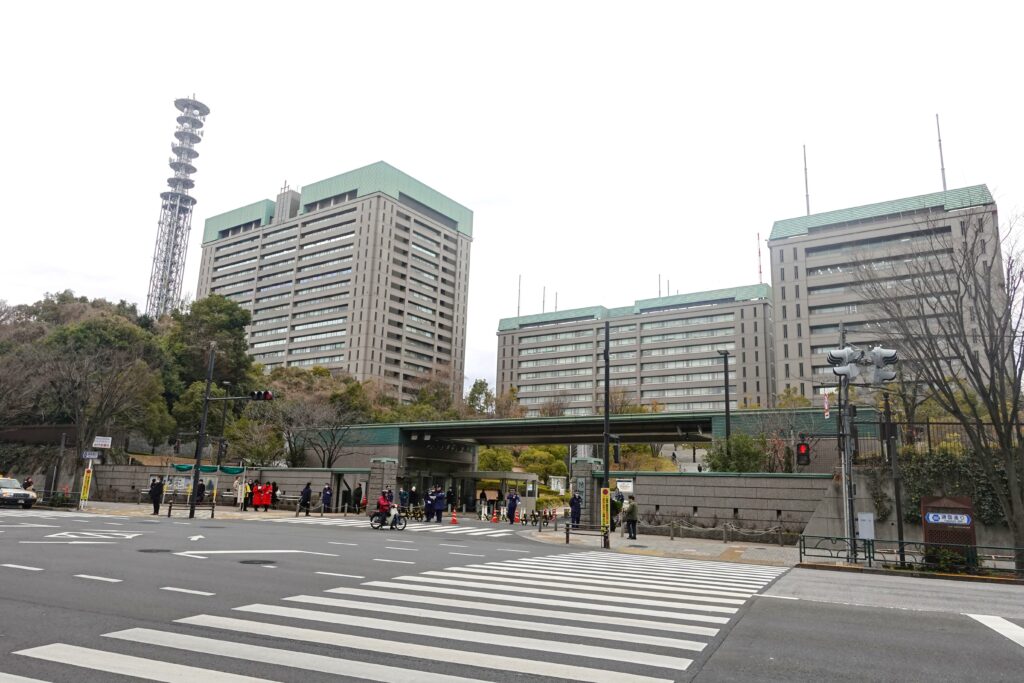
This is the current main gate of the Ministry of Defense.
The large building on the left side of the photo is where the building where Mishima gave his speech used to be. The building has now been relocated to another location as the Ichigaya Memorial Hall. We will visit there. Now, let us watch the video of Mishima's famous speech just before he committed suicide.
Watch this video and say, "Ah! Here it is!" I am sure that many of you may have seen this video and thought, "Ah! Even I, who did not live in this era, had seen this video before.
We will now look at the site of Yukio Mishima's suicide, but before that, let us take a closer look at the background of this event, known as the Mishima Incident or the Tatenokai Incident. (From here on, written by Masayasu Hosaka)Yukio Mishima and the Tatenokai Incident."I will quote from the following.
After this quote, I will tell you about my experiences in the area, so you may skip this passage if you would like to see the local situation first. However, if you know the aspects of the incident described here, you will see the situation in the field in a completely different light. I hope that everyone will learn about Mishima's spectacular final days. Let's get started right away.
Background of the Mishima Incident (Tatenokai Incident)
The incident in which writer Yukio Mishima and four members of the Tatenokai stormed into the Self-Defense Forces Eastern Area General Staff Office in Ichigaya was reported in detail by the media immediately after the incident. I do not intend to recount the incident in minute detail here. However, since the outline of the incident is sometimes an important momento in this book, I will only describe it in very broad strokes.
November 25. Yukio Mishima and Moritacertain victoryand four other members of the Tate no Kai entered the Self-Defense Forces police station in a used Corona. All five were wearing Tatenokai uniforms. The time was 10:55 am. Yukio Mishima had an appointment to meet with the commissioner, Masuda Kanetoshi, at 11:00 a.m.
According to Masuda's testimony ("Trial Record: The Yukio Mishima Incident"), he thought that Mishima himself would come to the appointment and was not told that the Tatenokai members would accompany him. A little before 10:00 a.m., Mishima entered with a member of the Tatenokai, sat down on a sofa set in the reception area, and introduced the four members, saying that they were the members who would be honored by the Tatenokai.
For a while, they discussed the Japanese sword Mishima was carrying. Masuda praised it, saying that it was a good sword.
Eventually, Mishima ordered the members to "bring a handkerchief," perhaps to wipe his sword. As if on cue, one of the members came up behind Masuda, choked him, covered his mouth, and held his hands. The rest of the members also went behind Masuda, took out a thin drawstring, quickly tied his hands and feet, and gagged him with a Japanese towel. Masuda lost his freedom of action.
Even at this point, Masuda thought that this was either a prank or a training exercise for the Ranger Unit, and that after completing all the activities, he would say, "We have become so strong! However, Mishima was staring at Masuda with his Japanese sword drawn. Seeing his expression, Masuda thought, "This is not normal.
In the trial of the Mishima case, the prosecutor's side clearly disclosed the events that took place during the trial in his opening statement. According to the statement, after Mashida's freedom was restrained, "Mishima brandished a Japanese sword, and Morita set up barricades with chairs, tables, flowerpots, etc. at the three entrances leading to the main entrance of the General Staff Office, the Chief of Staff Office, and the Deputy Chief of Staff Office.
When the staff members in the adjoining room learned of the abnormal state of the commissioner's office, they rushed into the room and got into a brawl with Mishima and the members of the Tatenokai. Mishima and others threatened to kill the commissioner if he did not get out of the room, and shouted at him, "I'll kill him if you don't get out of the room. During this time, the defendant Koga kept a general watch over the commissioner while gagging him with his hands.
After this, Mishima broke the window glass of the commissioner's office, showed a Japanese sword, and said, "I have a written demand. If you do so, I will spare your life. It included a demand that the Self-Defense Forces officers be assembled in the vestibule and that Mishima be allowed to make a speech there. The third paragraph also stated, "The remaining members of the Tatenokai (unrelated to this case) should be urgently assembled (in front of the balcony)." The SDF commanders accepted this as well, and ordered to contact the Ichigaya Kaikan to inform the members gathered there. Only one-third of the Tatenokai members were gathered at the hall, and it was unclear from Mishima's written request whether the other members would also be gathered there.
Through a microphone, the commanders ordered the Self-Defense Force officers to assemble in the courtyard in front of the commissioner's office. The Self-Defense Force officers gathered without knowing the details of the situation. There were about a thousand of them.
At about 11:55 a.m., Morita and Ogawa took down a banner from the balcony in front of the commissioner's office with a list of demands and scattered the proclamation they had prepared. At noon, Mishima came out onto the balcony and began his speech. Since he did not have a microphone, Mishima's earthly voice spread from the balcony, but it could not be heard clearly because the helicopter of the press was already in the air above the balcony.
The content of the speech was the same as the proclamation. The tape recorded by Bunka Hoso contains the following passage
"...... Gentlemen, after last year's 10.01 (referring to International Anti-War Day), you are no longer an army defending the Constitution. There is no chance for a constitutional amendment, which the SDF has waited for 20 years with blood and tears. It has been removed from the political program. Why didn't you notice that?
For a year since last October 21, I've been waiting for the SDF to get angry.
There is no more chance for a constitutional amendment! There will be no day when the Self-Defense Forces will become the national army! There is no real reason for the founding of a military! That's what I was most lamenting.
What is the true meaning of the founding of the Self-Defense Forces? To protect Japan. What is to protect Japan? To protect Japan is to protect the historical and cultural traditions centered on the Emperor. ......"
During this time, shouts of "Baka-yaro, come down," "You don't know what you are talking about," and "Pull him down" arose among the SDF members.
"Listen to me, listen to me! Be quiet. Be quiet! Listen to me!
One man is risking his life to appeal to you. Listen to me. Listen up.
If the Japanese people do not stand up now, if the Self-Defense Forces do not stand up, there will be no revision of the Constitution. You will forever be just another army of the U.S.S.R. You and Japan's ...... (inaudible due to field interrupts) (omitted)...... have been poisoned by civilian control. Civilian control, you see, is not the kind of civilian control we're going to have under the new Constitution."
Gentlemen, you are warriors. Gentlemen, you are warriors. If you are warriors, why are you defending a constitution that denies you? Why do you bow down to a constitution that denies you, for the sake of a constitution that you deny? As long as this exists, you will never be saved.
Gentlemen, the current Constitution is a political conspiracy ...... and you are pretending that it is constitutional, but the Self-Defense Forces are unconstitutional. The SDF is unconstitutional. You are unconstitutional.
The shouting and yelling increased even more. Mishima continues to scream. The afternoon sun shines on the brown Tate-no-Kai uniforms. The information that Mishima had not only taken the commissioner hostage, but had also slashed at the staff members, was now running through the JSDF. Some of them even ask, "Why did he hurt our commissioner?
Mishima's speech enters the final part. His voice dies down, and the plea is replaced by a voice squeezed out from the bottom of his stomach.
"Will any of you stand with me ......?"
Mishima was silent for about five seconds. The "idiot," "madman," and "who the hell cares about that? Of course, Mishima must have expected this. There was no way that any of them would have offered his hand and said, "All right, then, let's get up together.
'You don't have one. All right! What is a warrior, what is a sword? My mission ......(inaudible) ......Are you still a samurai? Still a samurai?
It is now clear to me that you have not yet risen up for the amendment of the Constitution. Now my dream of the Self-Defense Forces is gone. Now then, I will shout long live the Emperor.
Mishima sat on his knees facing the Imperial Palace and sang three chants of Hail to the Emperor.
This listen lasted about ten minutes.
Mishima returned to the commissioner's office and muttered to no one in particular, "I had no choice but to do it this way," Masuda testified at the trial. Then, facing each other on the balcony, he stripped off his uniform and sat down on the floor. He gripped a dagger with both hands and, in a spirited effort, stabbed Mishima in the left side of the stomach, causing him to commit seppuku. Morita, who was standing behind Mishima on his left, slashed at Mishima's neck, but "the first time, half or more or most of his neck was cut off, and he quietly fell forward" (Masuda's testimony in court). Morita then struck two more swords, and Koga struck one more sword to finish the intervention.
Morita then stripped off his uniform, sat down, placed a dagger to his stomach, and committed seppuku. When Morita signaled, "Okay," Koga intervened with a dagger. The prosecutor's opening statement describes what happened next as follows
After Mishima and Morita were finished, the three defendants turned both bodies on their sides and put their uniforms on them, then placed their palms together around the necks of the two men. After that, they untied the rope binding the commissioner, and the commissioner also laid his hands on the heads of the two defendants and held his hands together. The three accused then accompanied the commissioner to the commissioner's office, handed their Japanese swords to the self-defense officers, and were arrested by police officers at 20:20 p.m.
The above is what happened when Yukio Mishima and four members of the Tatenokai stormed into the Self-Defense Forces for one hour and 20 minutes from 11:00 am to 12:20 pm. The fact that two people committed suicide, seven Self-Defense Forces staff members were wounded by Japanese swords, and three Tatenokai members were arrested - that is the superficial phenomenon when we call it an "incident.
Chikuma Shobo, Masayasu Hosaka, Yukio Mishima and the Tatenokai Incident, p.46-52
This is a rather long quotation, but how was it? I hope that you have been able to understand Mishima's spectacular final days. It is impossible to convey the story simply by saying "Yukio Mishima committed suicide at a Self-Defense Forces base in 1970.
Cited in this issue.Yukio Mishima and the Tatenokai Incident."In the following section, we can look at the process that led to Mishima's suicide in considerable detail. In particular, the explanation of the formation of the Tatenokai, its progress, and Mishima's connection with the Self-Defense Forces was very interesting.
I can't introduce its contents here, but I was also surprised by the number of "eh! I can't tell you about the contents of the book here, but I can tell you that I was surprised by many things that came out. I think my view of Mishima changed before and after reading this book.
Why did Yukio Mishima have to die?
And in thinking about that, too.Yukio Mishima and the Tatenokai Incident."is a work that offers very important suggestions.
Also, in conjunction with this book, Takao Tokuoka, Ph.Goken no Hito: Yukio Mishima no Shikishi" (The Man of Five Decades: A Personal Memoir of Yukio Mishima)and by Houtarou NishiThe Yukio Mishima Incident: 50 Years Later - What Did the Police and Self-Defense Forces Know?'-' (used in place of '-')Written by Kiyoshi InuzukaThe Life of Yukio Mishima and the Man Who Died: Morita Masakatsuis also recommended.
Takao Tokuoka, the author of "Gokaku no Hito: A Personal Account of Yukio Mishima," was a reporter who was asked by Yukio Mishima himself to come to Ichigaya on the day of the incident and listen to his speech on the balcony. He was a reporter trusted by Yukio Mishima that much. Three years before the incident, Mr. Tokuoka and Mishima became friends in Bangkok and conducted various interviews. Among them, the part where Mishima talked about India was very interesting to me as a Buddhist monk. The book also includes a valuable interview with Mishima immediately after his enlistment in the Japan Self-Defense Forces and his subsequent development, which is described in detail from the reporter's point of view. This book is truly an insight into the unknown Yukio Mishima. This book is also extremely valuable for understanding Mishima's magnificent posthumous work, "The Sea of Fertility.
In the next book, "The Mishima Yukio Incident: Testimony of the Police and the Self-Defense Forces 50 Years Ago," as the title suggests, you will learn in detail how the police and the Self-Defense Forces viewed the incident and what the background was like at the time of the incident. The interview with Mr. Atsuyuki Sasa, who commanded the University of Tokyo's Yasuda Auditorium incident, reveals some shocking facts. In this book, you will learn that the Public Security Bureau was aware of Mishima's decision and how the upper echelons of the Bureau made their decision. I was stunned to read this book.... I highly recommend this book as well.
Another book, "Yukio Mishima and the Man Who Died: The Life of Hisshatsu Morita," provides a detailed account of Hisshatsu Morita of the Tatenokai, who committed suicide along with Mishima. The most significant feature of this book is the abundance of photographs of Morita and the Tatenokai. This book is very valuable for us to know various images of those who were involved in the incident.
Now, in the next article, I will finally tell you about my experience at the Ichigaya Memorial Hall.
Next Article.
Click here to read the previous article.
Related Articles












